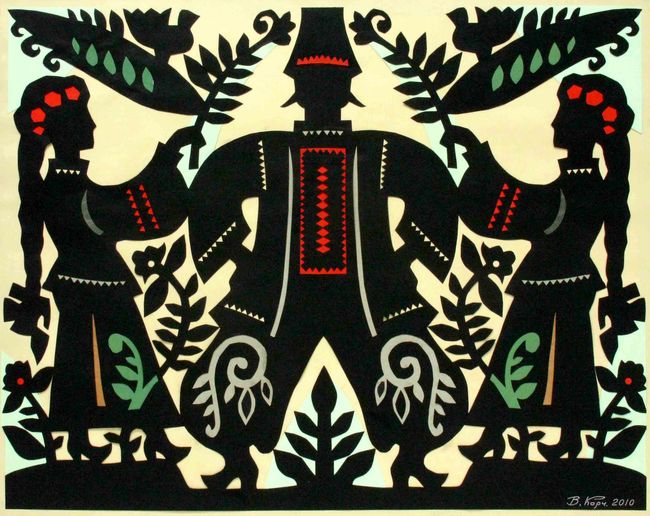Over the past decade Vasyl Korchynsky, a well-known painter and graphic artist from the capital, laureate of two Heorhii Yakutovych Awards, has earned the fame of an unsurpassed papercutting expert. He learned this a bit exotic form of art, which is more characteristic of rural life, and gave it a second wind, making a full-fledged book illustration out of ordinary paper decoration – nobody in Ukraine has undertaken such a challenge before!
It seems easy only at the first glance. Many will think that a decoration, suitable for every taste and appropriate for decorating a room on any occasion, can be created by simply folding an ordinary sheet of colored paper and cutting with scissors. In fact, amateurs of papercutting usually do just that, unaware of the ancient tradition of this folk craft. A professional, who wants to develop an artistic image, creates a completely different impression.
“I grew up in Podillia, and was occasionally involved in decorating our rural dwelling by mother and grandmother, mastering the secrets of papercutting,” Korchynsky reminisces. “The paper decorations were attached the ceiling beam, the water dispenser, the windows, and the furnace… Over time, I improved my papercutting technique, applying completely different crafting methods. The lack of quality colored paper compels me to create it on my own, utilizing about three hundred hues!”
Apparently, Korchynsky, working in the field of book design, was one of the first artists in Ukraine to transform papercutting into illustrations for literary works, folk songs, religious holidays etc. Studying at Kyiv evening school of book design of the Lviv Ivan Fedorov Polygraphic Institute, he dedicated his thesis to Mykhailo Kotsiubynsky. The illustrations for the Shadows of Forgotten Ancestors novel had been created in the late 1980s and are still being stored at the museum of Kotsiubynsky in Chernihiv.

PAPERCUTTING WILLOW HITS, NOT ME / Photo by Leonid LEVIT
“Looks like I came back to the Shadows of Forgotten Ancestors after thirty years, as the feeling of something incomplete, the need of re-evaluation grew inside me,” the artist says. “In 2010 a new series of 12 illustrations appeared, of which the papercutting became a principal graphic element. By the way, it is extremely difficult to reflect a storyline in the papercutting, in contrast to the other form of art – for instance, ink and pen drawings. That’s why the message in Childhood, Greeting of Trembitas, Holy Supper, To the Temple, Wedding Tree from the ‘Shadows of Forgotten Ancestors’ series is conveyed by symbols and signs present in the Kotsiubynsky’s novel.”
Reviewing the art of Korchynsky, one cannot help but notice the artist’s attempt in recreating myths and legends of pre-Christian era through his paintings and drawings. Here are the images of ancient Ukrainian sky goddess, Sun’s mother and Dazhboh’s wife (seen in Carols); the cattle god, patron of herdsmen and music (Sheep King); Master of the forest, defending the shepherds and woodcutters of Carpathian highlands (Chuhaister). His other series, “Rural life,” is composed of 30 works, related to the artist’s childhood and youth. The titles speak for themselves: My Childhood Play, Walk with the Cat, At the Fair, Shepherd, Near the Mill. A deeper philosophical meaning is imbued into the erotic triptych: Roden, Rodynia, and Rodannia, which reflect the author’s attempt to uncover the mysteries of the life’s origin on Earth.
“I think I was lucky when a few years ago my works had been exhibited at ‘Ukraine from Trypillia to the present day in the images of contemporary artists,’ a display organized by Oleksandr Melnyk, a well-known muralist. In my opinion, one of the paintings that were exhibited there deserves some attention. I am talking about Scythian Steppe, a triptych that shows the effort to delve into the ancient times, fragments of which are still carried by our genetic memory.”







